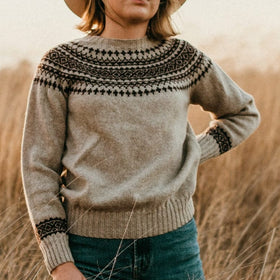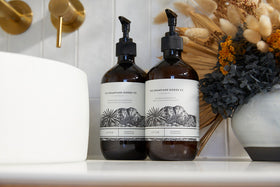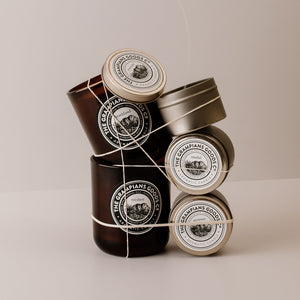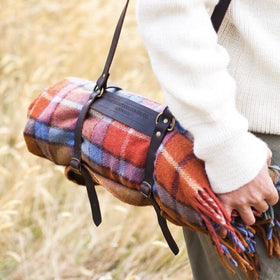
What’s the Difference Between Tartan and Gingham?
Tartan and gingham are two of the most enduring fabric patterns in the world, instantly recognisable, steeped in history, and beloved across generations. While they may seem similar at a glance, these patterns tell very different stories, each woven with its own origins, symbolism, and aesthetic charm.
At Grampians Goods Co., we honour timeless design and thoughtful living through textiles that carry meaning. Whether you’re drawn to the richness of tartan or the breezy charm of gingham, understanding the difference helps you choose with confidence and perhaps even a deeper appreciation for what you bring into your home.
Where Do Tartan and Gingham Come From?
Tartan and gingham may share a checkered appearance, but their roots couldn’t be further apart.
Tartan’s story begins in the misty Highlands of Scotland, where it was much more than a pattern, it was a marker of identity. Woven in wool and dyed with natural colours, these unique arrangements of stripes (known as setts) represented clans, families, and regions. Tartan became so entwined with Scottish pride that it was banned for nearly 40 years after the Jacobite uprising in the 18th century. Yet it endured. When the ban was lifted, tartan came roaring back, not just as a fabric, but as a symbol of resilience and belonging.
Gingham, in contrast, emerged from the trade routes of Southeast Asia and Europe. The word itself is believed to stem from the Malay term genggang, meaning “striped.” In the 17th and 18th centuries, gingham was exported to Europe and evolved into the small, evenly checked fabric we know today. Simple and cheerful, gingham became especially popular in British and French domestic life a fabric of everyday charm, often found in country kitchens and sunny garden settings.
Each pattern, in its own way, tells a tale of movement, culture, and endurance.
How Do Tartan and Gingham Look Different?
When you look closely, the contrast between tartan and gingham is as clear as night and day.
Tartan features a mix of colours in intersecting horizontal and vertical lines, often of varying widths. The result is a rich, layered design, complex, symmetrical, and full of depth. It’s the kind of pattern that feels bold, grounded, and deeply rooted in tradition.
Gingham, by comparison, is all about simplicity. Typically made with just two colours (most often white and one other), the checks are uniform and consistent, giving the fabric a crisp, clean appearance. There’s a lightness to gingham, a sense of easy-going charm that feels perfect for spring days and relaxed settings.
Where tartan speaks of heritage and structure, gingham offers breezy balance and everyday grace.
What Are They Commonly Used For Today?
In modern life, both patterns continue to weave their way into the fabric of our homes and wardrobes, though each carries a different seasonal and emotional tone.
Tartan finds its place in the cooler months, where warmth and texture are prized. At Grampians Goods Co., we celebrate tartan through our tartan wool blankets and tartan picnic rugs pieces designed not just for comfort, but for connection. Whether draped over a sofa or wrapped around your shoulders, tartan brings a sense of depth and familiarity to your space.
Gingham, on the other hand, shines in the light. It’s a go-to for picnic cloths, summer dresses, and kitchen linens patterns that conjure memories of fresh air, open windows, and sun-dappled tables. It’s less about statements, more about serenity.
Both serve a place in a thoughtful life each marking a different rhythm, mood, and season.
Which One Should You Choose?
When deciding between tartan and gingham, it often comes down to the atmosphere. If your heart leans towards earthy, timeless textures, tartan might be your pattern. It pairs beautifully with natural woods, leather, and candlelight, ideal for cooler seasons and cosy interiors. You might even find it in thoughtful gifts like our tartan recycled wool hot water bottle covers small luxuries that warm both body and soul.
If you're after a light, airy look, gingham could be your match. Perfect for spring mornings and garden parties, it brings brightness without overpowering a space, a quiet companion to natural light and fresh florals. And of course, there’s no rule saying you must choose one or the other. Many homes and many lives hold space for both.
Tartan vs Gingham: Bringing Timeless Patterns into the Present
At a glance, tartan and gingham may appear similar, but their stories are woven from very different threads. One speaks of heritage, resilience, and bold tradition, the other of simplicity, travel, and soft nostalgia. Here at Grampians Goods Co., we believe in surrounding yourself with things that tell stories. Whether that means the structured confidence of tartan or the breezy optimism of gingham, both offer more than pattern, they offer meaning. Explore our collection of all picnic blankets and let timeless design become part of your everyday life.








Leave a comment